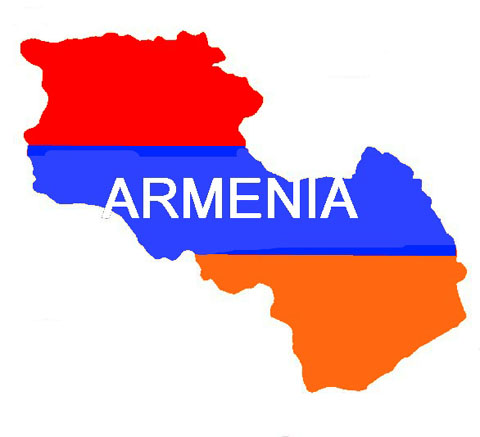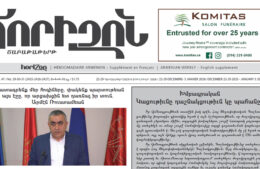Armenia Keeps on Balancing: Between the European Union and the Eurasian Economic Union
- (0)
Armenia Keeps on Balancing: Between the European Union and the Eurasian Economic Union –

By Sergey Minasyan
PONARS Eurasia
Armenia’s accession to the Russia-led Eurasian Economic Union (EEU) earlier this year appeared to further pigeonhole Armenia as Russia’s enduring ally. Nonetheless, Yerevan continues to seek political and commercial equilibrium in its relations with Russia and the West. Although the economic benefits of joining the EEU have been minimal, Armenia joined the bloc for political and security-oriented reasons, not economic and financial ones.
Now that Armenia’s “status” in the EEU has been clarified, Yerevan has the confidence to re-engage the European Union. Armenia attended the May 2015 EU Eastern Partnership Summit in Riga and, after a lull, is negotiating a new cooperative framework with Brussels. A balanced approach in building relations with the EEU and EU will remain a core element of Armenia’s foreign policy.
Armenia and the EEU: Pending Problems and Vague Dividends
The process of Armenia’s accession to the EEU was a difficult one. Armenia’s September 2013 decision to join the Russian-led Customs Union (and, from January 2015, the EEU) was taken under direct pressure from Moscow. As a result, Yerevan withdrew from its planned Association Agreement (AA) and Deep and Comprehensive Free Trade Area (DCFTA) with the EU.
The other founding EEU members, Kazakhstan and Belarus, were not particularly supportive of the push to make Armenia a member. For example, Astana’s position, at least publicly, partly reflected considerations of so-called “Turkic solidarity” with Azerbaijan. In the end, both countries came to view Armenia’s accession as a kind of lever they could use against Moscow to achieve more concessions and economic preferences.
There were also domestic issues involved. Civil society and some political circles in Armenia were nervous about acceding to the EEU. One issue that was artificially inflated concerned the need to establish a “customs border” between Armenia and Nagorno-Karabakh (a non-recognized political entity that would not be an EEU member). It was clear from the start, however, that any such formal obstacles could be overcome. Armenia and Nagorno-Karabakh continue to enjoy a common political, economic, military-strategic, and humanitarian space, and no customs checkpoints have appeared between them.
Armenia’s January 2015 accession process to the EEU went relatively unnoticed by most. However, it entered local and international headlines almost immediately, when a terrible tragedy occurred that highlighted the accumulation of discontent in Armenian society with Russia and its policies toward Armenia. On an early January morning, seven members of a family were murdered in Armenia’s second largest city, Gyumri, near the Turkish border and where Russia’s 102nd military base is deployed. Russian serviceman Valery Permyakov was suspected of the crime.
Russian border guards detained Permyakov as he attempted to cross the Armenian-Turkish border and took him to the Russian military base. According to existing agreements and previous practice, he was to be prosecuted by Armenian authorities. However, the Russians refused to hand him over. This caused spontaneous protests in Gyumri and Yerevan, releasing a depth of accumulated grievances and discontent. Even Russian researchers noted the crisis of confidence the incident caused in Armenian-Russian relations.
Armenian discontent with Russia became more evident during the so-called “Electromaidan” this past June, when planned electricity price hikes triggered street protests in Yerevan. Demonstrators expressed anger at both Armenian officials and the electricity distributor InterRAO, a Russian-owned company. In Moscow, the demonstrations were perceived as a possible repeat of Kyiv’s Euromaidan; even in Yerevan, some interpreted the protests as an “Armenian Euromaidan.” In the end, the Armenian government made concessions, temporarily freezing electricity prices and launching an international audit of the electricity company.
The Electromaidan led to a nervous, rapid, and “reassuring” reaction from Moscow, which saw some danger in Armenia’s deepening anti-Russian sentiments. The Kremlin turned Permyakov over to an Armenian court and announced its intent to provide Armenia with a $200 million soft loan (for the purchase of advanced Russian weapons). The Kremlin also raised the possibility of supplying Armenia with Iskander tactical missile systems.
The Benefits of the EEU: Projected and Real
Given the specific circumstances of Armenia’s EEU membership (including the lack of land borders with other members), Armenia joined the organization under special conditions. More than 800 types of imported goods were exempted from higher customs duties until 2022. Duties on natural gas, petroleum products, and rough diamond deliveries from Russia were abolished, saving Armenia around $200 million annually. To compensate for the devaluation of the Armenian dram at the end of 2014, which was linked to Russia’s own sanctions-related crisis, Moscow reduced gas prices for Armenian consumers the following spring.
Soon after its accession, Armenia expected to receive 1.13% of the total amount of EEU customs duties, as specified in the organization’s framework. This was projected to yield $250-300 million annually, significantly exceeding the amount of customs duties that Armenia was collecting prior to joining the bloc. By mid-2015, however, it became clear that with the drop in oil price, sanctions, and Russia’s economic downturn, Armenia’s EEU-related economic benefits would be far more moderate, around $50-70 million. It also became clear that significant investments from Russia were unlikely to be forthcoming in the coming years.
In the end, however, Armenia’s decision to join the EEU was not primarily economic but political and security-oriented. The financial consequences do not seriously alter the outlook for its membership.
Armenia-EU: Slow Institutionalization in the Shadow of Political Constraints
From September 2013 until the fall of 2014, the EU and Armenia took a “time out” from initiatives to institutionalize their cooperation. In the shadow of the Ukraine conflict, Brussels and Yerevan needed to wait for Armenia’s membership in the EEU to be finalized before they could construct a new format for cooperation—one that would be in harmony with Armenia’s EEU commitments. In mid-May 2015, prior to the Eastern Partnership’s Riga Summit, Ambassador Traian Hristea, former head of the EU Delegation to Armenia, declared that the EU’s new proposal package to strengthen bilateral cooperation with Armenia included multiple areas. According to Hristea:
“[S]ince the beginning of this year, we have begun implementing so-called revised obligations, or reapproved agreements, with Armenia, including a full financial package of €140-170 million….It is worth noting that even if this assistance is recalculated per capita, we may say that it is comparable and even equal to the assistance provided to those countries that have already signed an Association Agreement.”
Around the same time, the European Commission adopted a recommendation for the Council to authorize the opening of negotiations on a legally binding agreement between the EU and Armenia. In the joint Declaration of the Riga Eastern Partnership Summit it was noted that:
“Participants welcome the common understanding reached on the scope for a future agreement between the EU and Armenia aimed at further development and strengthening their comprehensive cooperation in all areas of mutual interest.”
The final approval process could be completed this fall, with Yerevan and Brussels initialing the framework document as early as the year’s end. The agreement is expected to be a “light” version of the original Association Agreement that Armenia and the EU signed in 2013.
The Riga Summit was of vital importance for Armenia’s development as it upheld the EU’s incentive-based approach (“more-for-more”), according to which EU financial support is conditioned on concrete reforms—reforms that will benefit Armenia. When the president of the European Council, Donald Tusk, visited Armenia in July, he confirmed the readiness of the EU “to reinvigorate interaction in the wake of Riga Summit. We will help you push ahead with your reform agenda which is quite ambitious.” He stated that a visa-free regime with Armenia should be “the final goal” of the bilateral visa liberalization dialogue and “the next step can be taken in the coming months.”
This does not mean, however, that after the Riga Summit relations between Armenia and the EU will be bereft of problems and challenges. On the contrary, the obvious geopolitical restrictions will remain and not diminish; their severity will depend on how relations between Russia and the EU unfold. Armenia will stay on the safe side and avoid antagonizing Brussels or Moscow. During the Riga Summit, for instance, Armenia refused to sign the first draft of the declaration, which mentioned that “Russia occupied the Crimea.”
Recent signals from Brussels demonstrate that the EU is going to modify its format and “philosophy” toward the Eastern Partnership program, allowing for a more diversified approach toward partner states. Armenia certainly intends to cooperate with Western countries and organizations even though it joined the EEU. For example, in May 2015, Armenia and the United States signed a Trade and Investment Framework Agreement, which created favorable conditions for bilateral trade, financial, and economic cooperation.
Conclusion
Armenia’s accession to the EEU in early 2015 has not yet resulted in any significant positive economic impact. Russia’s own economic crisis played a role in this, as has the institutionally and economically weak structure of the EEU. Still, Armenia has not experienced any specific negative consequences either. Instead, joining the EEU has potentially prevented Armenia from becoming the site of another geopolitical confrontation between Russia and the West.
By the summer of 2015, Yerevan and Brussels managed to resume a process of institutional cooperation that had been suspended since September 2013. Preparations for a new framework agreement with the EU will once again let Armenia demonstrate its traditional foreign policy balance. However, Yerevan is now taking more cautious steps, which is rather natural under the current circumstances. There is no need to irritate Moscow right now. For its part, Brussels has also demonstrated more flexibility and understanding in regard to Yerevan’s position.
In the event that Brussels is unable to offer anything more significant to Armenia in key areas like energy and security, a situation of permanent déjà-vu and ambiguity in relations between Armenia and the EU will be maintained. Even so, for the foreseeable future, Armenia will still maintain better relations and a higher level of integration with the EU (and NATO) than its other EEU partners.
Sergey Minasyan is Deputy Director and Head of Political Studies at the Caucasus Institute (Armenia).


















